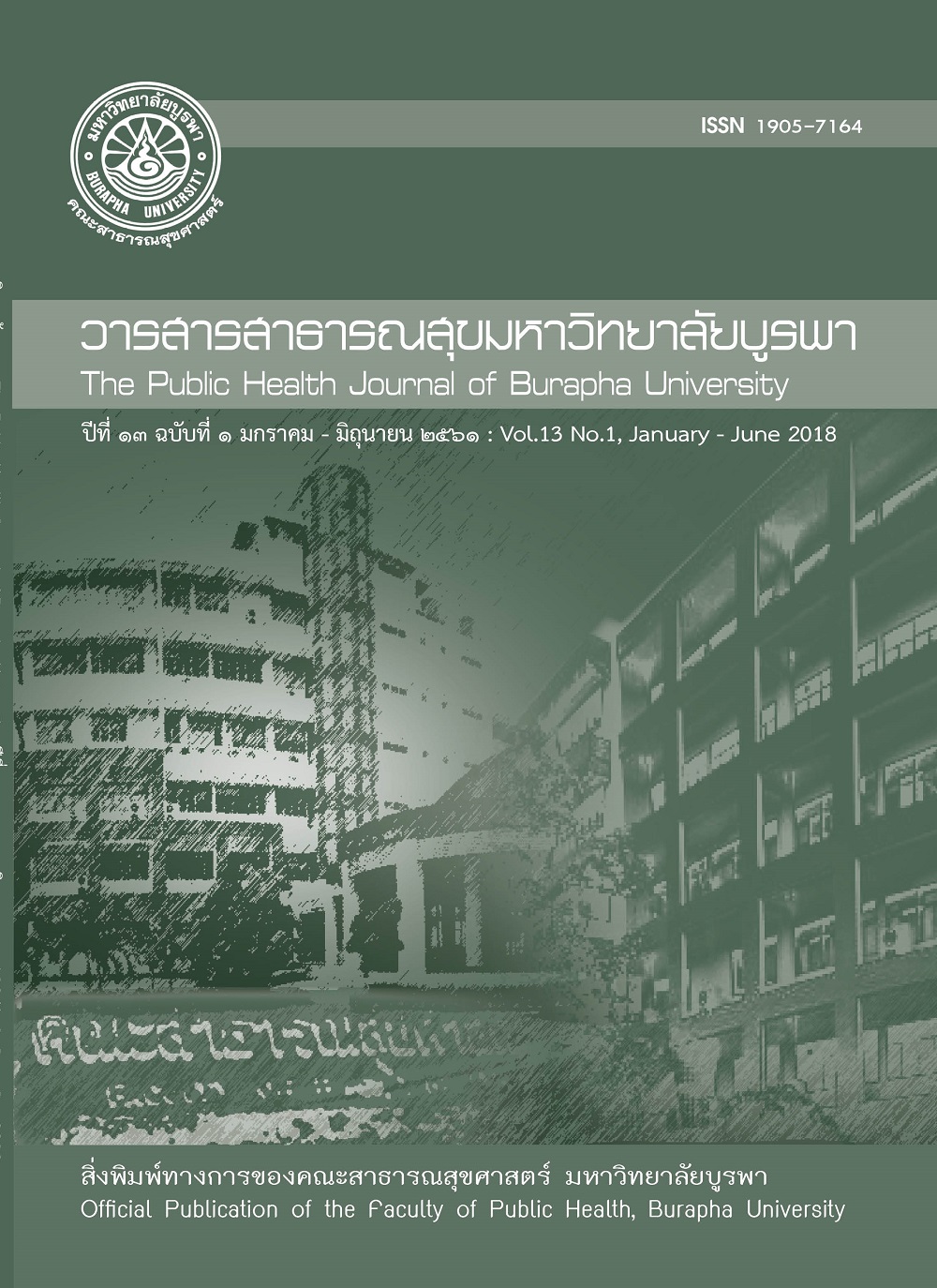การศึกษาความแตกต่างของมุมคอยื่นไปด้านหน้าในกลุ่มคนสุขภาพดีที่ใช้แท่นวางแขน และที่ไม่ใช้แท่นวางแขนเล่นสมาร์ทโฟน
Main Article Content
บทคัดย่อ
ท่าทางในการใช้สมาร์ทโฟนเป็นท่าที่ต้องก้มคอเพื่อจ้องมองหน้าจอ ทำให้คอมีลักษณะยื่นไปด้านหน้า ส่งผลให้กล้ามเนื้อคอทำงานมากขึ้นเพื่อให้ศีรษะตั้งตรงกลับสู่แนวเดิมได้ การอยู่ในท่าทางคอยื่นเป็นเวลานานส่งผลให้เกิดแรงเครียดที่กระทำต่อกระดูกสันหลังและกล้ามเนื้อบริเวณคอและนำไปสู่การเกิดการบาดเจ็บและอาการปวดคอได้ การศึกษาครั้งนี้มีวัตถุประสงค์เพื่อเปรียบเทียบความแตกต่างของมุมการยื่นคอมาด้านหน้าในกลุ่มคนสุขภาพดีที่ใช้แท่นวางแขนและไม่ใช้แท่นวางแขนเล่นสมาร์ทโฟน อาสาสมัครทั้งหมดจะได้รับการตรวจประเมินเบื้องต้นตามเกณฑ์การคัดเข้าและคัดออก จากนั้นได้รับการสุ่มออกเป็นสองกลุ่ม คือ ผู้ที่มีสุขภาพดีที่ใช้แท่นวางแขนขณะเล่นสมาร์ทโฟนจำนวน 6 คน และผู้ที่มีสุขภาพดีที่ไม่ใช้แท่นวางแขนขณะเล่นสมาร์ทโฟนจำนวน 6 คน อาสาสมัครทั้งสองกลุ่มจะได้รับการประเมินมุมการยื่นคอไปด้านหน้าโดยใช้ 3-point marker detection program ผลการศึกษาพบว่ามีความแตกต่างอย่างมีนัยสำคัญทางสถิติภายในกลุ่มและระหว่างกลุ่มของค่ามุมคอยื่นไปด้านหน้าในกลุ่มคนสุขภาพดีที่ไม่ใช้แท่นวางแขนและใช้แท่นวางแขน หลังจากใช้สมาร์ทโฟนเป็นเวลา 30 นาที (p=0.01และ p=0.02) ตามลำดับ สรุปผลการศึกษา พบว่าค่ามุมคอยื่นไปด้านหน้าในกลุ่มคนสุขภาพดีที่ไม่ใช้แท่นวางแขนมีมุมคอยื่นไปด้านหน้ามากกว่ากลุ่มคนสุขภาพดีที่ใช้แท่นวางแขนเล่นสมาร์ทโฟน ดังนั้นการใช้สมาร์ทโฟนเป็นเวลานานควรมีที่รองรับท่อนแขนเพื่อลดการก้มคอและป้องกันการปวดกล้ามเนื้อคอที่อาจจะเกิดตามมา
Article Details
เอกสารอ้างอิง
Abo-Jedi, A. (2008). Cellphone addiction and its relation to self-closure in a sample of Jordanian university and Amman private university students. The Jordanian Journal for Educational Sciences, 4, 137-150.
กระทรวงเทคโนโลยีสารสนเทศและการสื่อสาร, สำนักงานพัฒนาธุรกรรมทางอิเล็กทรอนิกส์(องค์การมหาชน). รายงานผลการสำรวจพฤติกรรมผู้ใช้อินเทอร์เน็ตในประเทศไทย ปี 2559 (Thailand Internet User Profile 2016). เข้าถึงได้จาก https://www.it24hrs.com/2016/etda-thailand-internet-user-profile-2016.
Kim HJ, Kim JS. (2015). The relationship between smartphone use and subjective musculoskeletal symptoms and university students. Journal of physical therapy science, 27(3), 575-79.
Jung SI, Lee NK, Kang KW, Kim K, Do YL. (2016). The effect of smartphone usage time on posture and respiratory function. Journal of physical therapy science, 28(1), 186-189.
Park J, Kim K, Kim N, Choi I, Lee S, Tak S. (2015). A comparison of cervical flexion, pain, and clinical depression in frequency of smartphone use. International Journal of Bio-Science and Bio-Technology, 7(3), 183-90.
Kim SE, Kim JW, Jee YS. (2015). Relationship between smartphone addiction and physical activity in Chinese international students in Korea. Journal of behavioral addictions, 4(3), 200-5.
Lepp A, Barkley JE, Sanders GJ, Rebold M, Gates P. (2013). The relationship between cell phone use, physical and sedentary activity, and cardiorespiratory fitness in a sample of US college students. International Journal of Behavioral Nutrition and Physical Activity, 10(1), 79.
Lee J, Seo K. (2014). The comparison of cervical repositioning errors according to smartphone addiction grades. Journal of physical therapy science, 26(4), 595-98.
Szeto GP, Lee R. (2002). An ergonomic evaluation comparing desktop, notebook, and subnotebook computers. Arch Phys Med Rehabil, 83(4), 527-32.
Lee JH, Park SY, Yoo WG. (2011). Changes in craniocervical and trunk flexion angles and gluteal pressure during VDT work with continuous cross-legged sitting. Journal of occupational health, 53(5), 350-55.
Lee S, Lee D, Park J. (2015). Effect of the cervical flexion angle during smart phone use on muscle fatigue of the cervical erector spinae and upper trapezius. Journal of physical therapy science, 27(6), 1847-49.
Lee TH, Liu TY. (2013). Postural and muscular responses while viewing different heights of screen. International Journal of Occupational Safety and Ergonomics, 19(2), 251-58.
Hansraj KK. (2014). Assessment of stresses in the cervical spine caused by posture and position of the head. Surg Technol Int, 25(25), 277-9.
Xie Y, Szeto GP, Dai J, Madeleine P. (2016). A comparison of muscle activity in using touchscreen smartphone among young people with and without chronic neck–shoulder pain. Ergonomics, 59(1), 61-72.
สุกัญญา อังศิริกุล, น้ำอ้อย ภักดีวงศ์, วารินทร์ บินโฮเซ็น. (2559). ปัจจัยที่มีความสัมพันธ์กับพฤติกรรมส่งเสริมสุขภาพในผู้ป่วยที่มีอาการปวดหลังส่วนล่าง. วารสารคณะพยาบาลศาสตร์ มหาวิทยาลัยบูรพา, 24(1), 39-50.
วะนิดา น้อยมนตรี, นัยนา พิพัฒน์วณิชชา. (2558). พฤติกรรมเสี่ยงต่อสุขภาพของนิสิตระดับปริญญาตรีมหาวิทยาลัยรัฐแห่งหนึ่ง. วารสารคณะพยาบาลศาสตร์ มหาวิทยาลัยบูรพา, 23(2), 31-40.
Beatriz G, M., VILLANUEVA, Hiroshi JONAI, H and SAITO S., (1998). Ergonomic Aspects of Portable Personal Computers with Flat Panel Displays (PC-FPDs): Evaluation of posture, muscle activities, discomfort and performance. Industrial Health, 36, 282-89.
Hassaine M, Hamaoui A, Zanone PG. (2015). Effect of table top slope and height on body posture and muscular activity pattern. Annals of physical and rehabilitation medicine, 58(2), 86-91.
Lee S, Kang H, Shin G. (2015). Head flexion angle while using a smartphone. Ergonomics, 58(2), 220-26.
Taweekarn P, Boonprakob Y, Sae-lee D, Johns TP, Ungpansattawong, S, Ruammahasab S. (2012). A test of validity and reliability between the three-point marker detection software method and goniometry. Journal of Medical Technology and Physical Therapy Khon Kaen University, 25(2), 172-80.
Lee KJ, Han HY, Cheon SH, Park SH, Yong MS. (2015). The effect of forward head posture on muscle activity during neck protraction and retraction. Journal of physical therapy science, 27(3), 977-79.
Peolsson A, Ludvigsson M., L, Overmeer T, Dedering A, Bernfort L, ohansson G, Kammerlind A, and Peterson G. (2013). Effects of neck-specific exercise with or without a behavioural approach in addition to prescribed physical activity for individuals with chronic whiplash-associated disorders: a prospective randomised study. BMC Musculoskeletal Disorders, 14, 311.
Gustafsson E, Johnson PW, Lindegard A, Hagberg M. (2011). Technique, muscle activity and kinematic differences in young adults texting on mobile phones. Ergonomics, 54(5), 477-487.
Chiu Hsiao-Ping, Tu Chia-Nai, Wu Shu-Kai and Hsiou Liu Chien. (2015). Muscle Activity and Comfort Perception on Neck, Shoulder, and Forearm While Using a Tablet Computer at Various Tilt Angles. International Journal of Human–Computer Interaction. 31(11), 1-10.
Vuillerme N, Pinsault N, Bouvier B. (2008). Cervical joint position sense is impaired in older adults. Aging clinical and experimental research, 20(4), 355.
Pinsault N, Vuillerme N. (2010). Degradation of cervical joint position sense following muscular fatigue in humans. Spine, 35(3), 294-97.
Kerr, A. (2010). Introductory biomechanics. China: Churchill Livingstone.
Kapandji, A, I., (2008). The Physiology of the Joints, volume III (6 edition). China: Churchill Livingstone.
Shin H, Kim K. (2014). Effects of cervical flexion on the flexion-relaxation ratio during smartphone use. Journal of physical therapy science, 26(12), 1899-1901.

